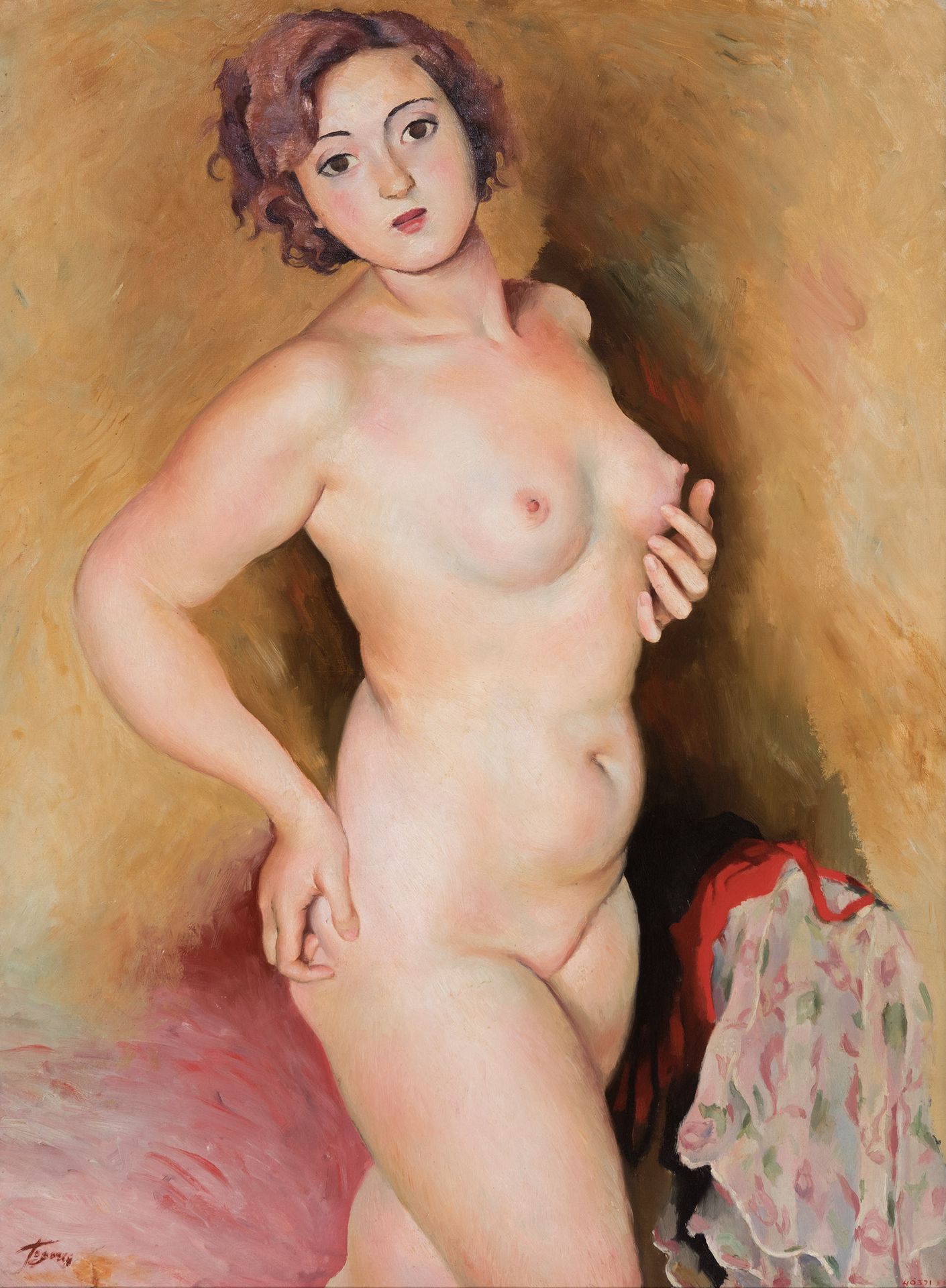Description
JOSEP DE TOGORES LLACH (Cerdanyola del Vallès, 1893 - Barcelona, 1970). "Female nude". Oil on canvas. Signed in the lower left corner. Measurements. 100 x 73 cm; 119 x 92 cm (frame). With this female nude, of modern concept, Togores departs from the pictorial tradition centred on the representation of languid and passive women. The body of this young woman, on the other hand, exposes itself unashamedly, and she even caresses her breast with one hand while pinching her buttock with the other. The smooth, voluptuous carnality has been resolved with the virtuoso technique that characterised Togores's work. Born into a wealthy, cultured family who frequented intellectual circles, his interest in painting began at the age of thirteen, when he lost his hearing due to meningitis. He travelled to France and Belgium, where he discovered the paintings of Rembrandt, and at the 1907 International Art Exhibition in Barcelona he was fascinated by the work of Monet. At the age of eighteen he was already an important artist in Barcelona, and in 1913 he was commissioned to decorate the chapel of Anna Girona in Poblet. With a grant from Barcelona City Council, he moved to Paris to study, where he became acquainted with the painting of Cézanne, who was to be a decisive influence on his work from then on. In 1917 he met Picasso and came into contact with cubist theories and circles. In the 1920s he began his relationship with the gallery owner Kahnweiler, who later became Picasso's dealer. He worked exclusively with him between 1921 and 1931, when his painting underwent its most experimental period, coming close to automatism and surrealism. Under Kahnweiler's guidance he became an enormously successful artist. In 1932 his painting took a new turn, a return to figuration. He moved to Barcelona and worked with a new dealer, Francesc Cambó. During this period he produced a large number of portraits of the most important figures in Catalan society, and became one of the most sought-after painters of the time. During the Civil War he moved to France, but returned in 1939, where he continued to work, without having lost any of his prestige. His work can be found in the Museo Patio Herreriano in Valladolid, the Museo Nacional Reina Sofía, the Museo Nacional del Arte de Cataluña, the Getty Museum (Los Angeles), the Museo de Arte de Sabadell, the Städtisches Gelsenkirchen Museum (Germany), the Thyssen-Bornemisza Museum (Madrid), the Palacio Nacional de Montjuic and the Centre Georges Pompidou (Paris), among others.
69
JOSEP DE TOGORES LLACH (Cerdanyola del Vallès, 1893 - Barcelona, 1970). "Female nude". Oil on canvas. Signed in the lower left corner. Measurements. 100 x 73 cm; 119 x 92 cm (frame). With this female nude, of modern concept, Togores departs from the pictorial tradition centred on the representation of languid and passive women. The body of this young woman, on the other hand, exposes itself unashamedly, and she even caresses her breast with one hand while pinching her buttock with the other. The smooth, voluptuous carnality has been resolved with the virtuoso technique that characterised Togores's work. Born into a wealthy, cultured family who frequented intellectual circles, his interest in painting began at the age of thirteen, when he lost his hearing due to meningitis. He travelled to France and Belgium, where he discovered the paintings of Rembrandt, and at the 1907 International Art Exhibition in Barcelona he was fascinated by the work of Monet. At the age of eighteen he was already an important artist in Barcelona, and in 1913 he was commissioned to decorate the chapel of Anna Girona in Poblet. With a grant from Barcelona City Council, he moved to Paris to study, where he became acquainted with the painting of Cézanne, who was to be a decisive influence on his work from then on. In 1917 he met Picasso and came into contact with cubist theories and circles. In the 1920s he began his relationship with the gallery owner Kahnweiler, who later became Picasso's dealer. He worked exclusively with him between 1921 and 1931, when his painting underwent its most experimental period, coming close to automatism and surrealism. Under Kahnweiler's guidance he became an enormously successful artist. In 1932 his painting took a new turn, a return to figuration. He moved to Barcelona and worked with a new dealer, Francesc Cambó. During this period he produced a large number of portraits of the most important figures in Catalan society, and became one of the most sought-after painters of the time. During the Civil War he moved to France, but returned in 1939, where he continued to work, without having lost any of his prestige. His work can be found in the Museo Patio Herreriano in Valladolid, the Museo Nacional Reina Sofía, the Museo Nacional del Arte de Cataluña, the Getty Museum (Los Angeles), the Museo de Arte de Sabadell, the Städtisches Gelsenkirchen Museum (Germany), the Thyssen-Bornemisza Museum (Madrid), the Palacio Nacional de Montjuic and the Centre Georges Pompidou (Paris), among others.
